“Let’s Build a Chicken Coop” is often preceded by “Let’s Get Chicks!” At first glance, the process seems so simple. And it is…but depending on your design and chicken coop goals, some coops may be easier than others. My goal is to coach you along the Q&A and design process, so the end result is that you know exactly what you want in a coop.
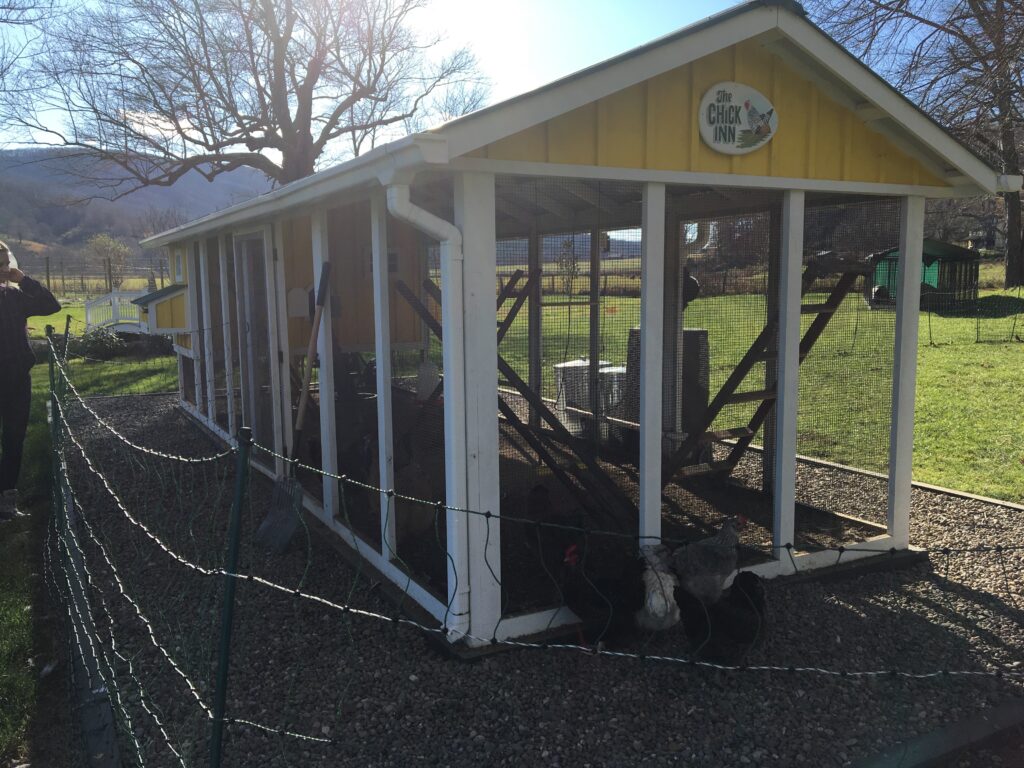
What to Consider Before Building
Let’s consider a few things, and then you’ll be ready to purchase necessities, or gather supplies to repurpose. Answer these questions and the planning stage will be well on its way.
- What weather and temperatures will your chickens be exposed to? Wind, exteme heat, cold, or excess moisture?
- What predators are likely? Neighborhood dogs and cats, or foxes, racoons, and possums?
- Will they be free ranging or entirely enclosed?
- Do you plan to collect eggs by going inside of the coop, or via a door that allows for exterior egg collecting?
- How do you plan to feed and water them?
- Will the coop have electricity or need access to electricity?
- How many chickens will you have?
- What style are you going for? Something functional? A certain asthetic?
- What is your budget?
Now, let’s figure out which coop is best for you. There are various coop styles. Some folks prefer picking up a kit. Others want something mobile or stationary. Then there’s the population of DIYers who want to build their own.
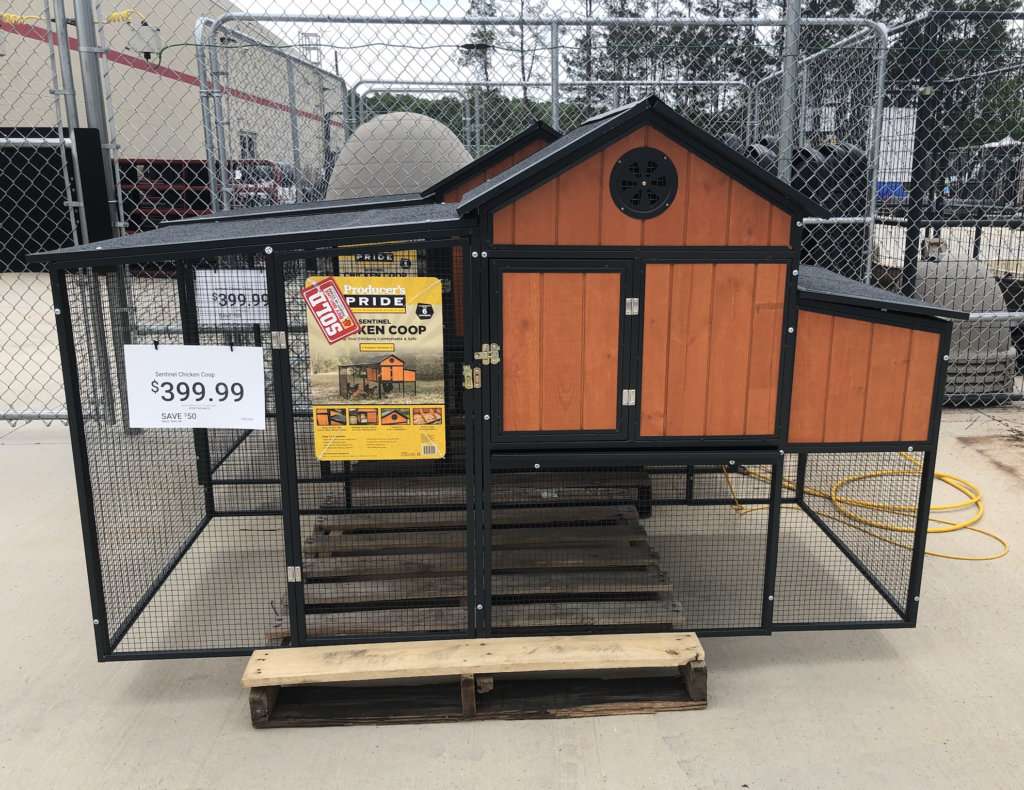
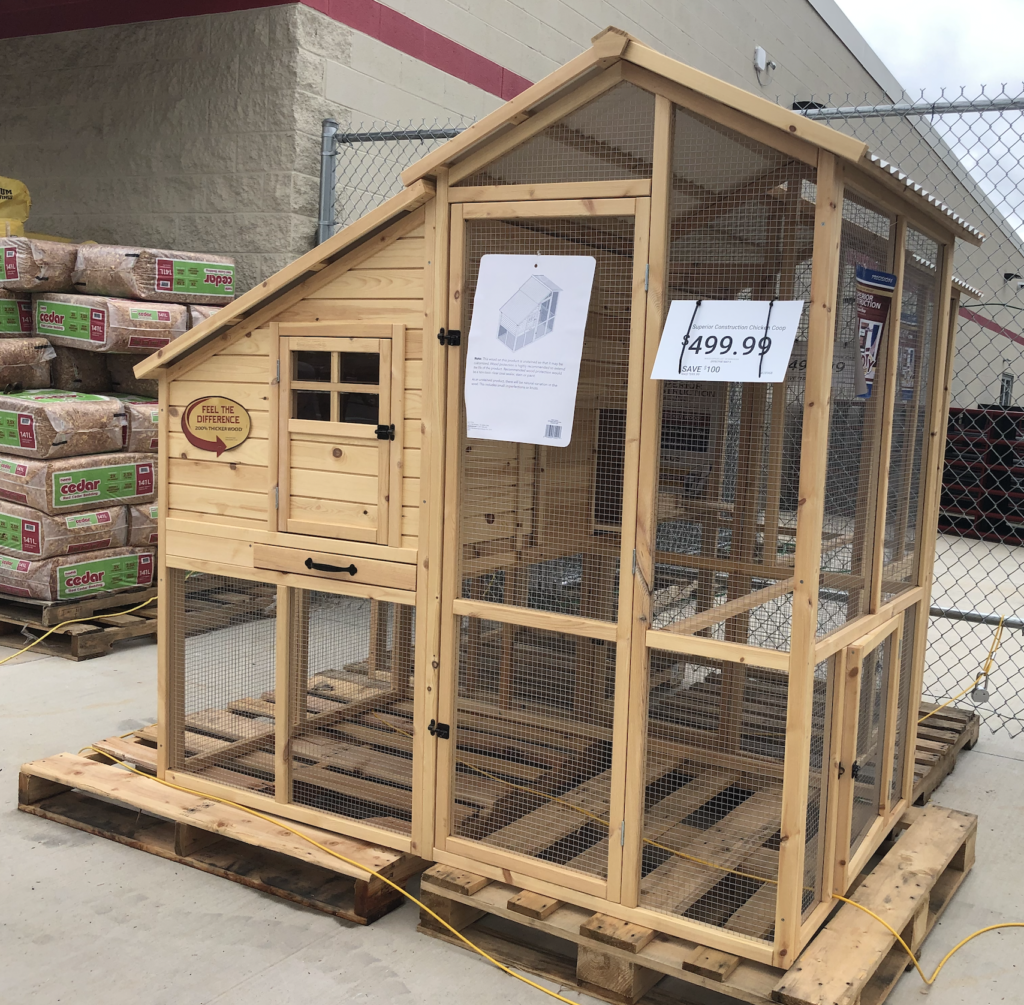
A quick Pinterest search shows just how elaborate chicken coops can be. Some people prefer the chicken tractor style, so they can move the chicken tractor around the property. This allows for access to fresh grass and bugs. Others definitely want something stationary and permanent. There are pros and cons to consider with either style.
Chicken Coop Kits
First, I want to mention something about those kits (above) while it’s on my mind. I have not seen many of those kits last for more than a few years. The materials used in their construction are thin and lack the robustness to handle season after season of weather. I’m just speaking from observation of these coops in the Virginia and North Carolina regions. Consider spending that same amount on materials and construct something that will last a lot longer. Those kits are cute, when they are first assembled, but like I mentioned, they look very different a couple of years later. Quality and longevity may not matter if you’re not sure about whether chickens will be an experiment or a long term commitment and you’re just testing the waters.
I digress….back to the pros and cons of mobile vs. stationary coops…
Chicken Tractor Pros & Cons
Considering a mobile option that allows you to move chickens around to tackle ticks and pests? Read below for benefits and drawbacks.
Pros
Niftly little mobile coops, also known as chicken tractors, can be built to accomodate a range of birds from just a few, to over 20. You can get great DIY ideas from Pinterest, order a mobile coop for less than $200, or upgrade to a hip stylish Omlet Portable Chicken Coop.
Overall, chicken tractors ensure that birds are always on a fresh area of ground. Some people prefer to move them every day, and others leave them in place for several days at a time.
Cons of Mobile Coops
Unless you are purchasing a coop that is lightweight and designed for ease of moving, mobile coops can be heavy and cumbersum. If constructed as a DIY, the materials can make moving it a challenge for one person without the use of a 4-wheeler or tractor. Also, if placed on uneven ground, chicks and small birds may escape, or be at risk of invading predators.
Omlet Portable Chicken Coops
Omlet Portable Chicken Coops are modern, attractive, and lightweight. They definitely have a hip vibe to them. Literally, they are the ideal urban coop for small areas, or for a small flock needing ease of mobility and predator protection!
The first time I heard of this nifty brand of coop was at my dentist’s office. The hygenist was cleaning my teeth, so she had a captive audience to tell me all about her portable Eglu Go Omlet Chicken Coop, and how well it was working for her. Acutally, she didn’t have a negative thing to say about it and she shared photos. In fact, she made such an impression on me that I went right home and looked into the company.
Omlet even makes a Universal Automatic Chicken Coop Door that works great for giving your chickens an added layer of protection from the elements and predators. It’s reasonably priced, too!
Another plus about this coop, is its ease of moving. Trust me, I’ve struggled with lugging a DIY coop around the property. In my case, the materials were heavy, bulky, and just the act of moving it put my back, and my chickens’ lives, in jeopardy. You get what you pay for. Don’t take my word for it! Check out the reviews!
Stationary Chicken Coop
A permanent structure is sometimes the best way to go, especially if you plan on explanding your flock. It can be designed with a specific asthetic, more features and attachments, because it’s stationary. Enclosed runs can be attached to the coop, thus eliminating the need to open coops in the morning, and close them up at night. However, a stationary coop is not for everyone, especially if you’re renting. Read below to determine if this kind of coop is ideal for you.
Pros
Stationary coops can be as elaborate as matching a home’s style and design, or as basic as a square or A-frame structure. They can also be designed to protect birds against extreme temperatures and predators. Gutters can be used to divert rainwater into a barrel that can serve as a water source. They eliminate the need for using waterhoses, or filling jugs of water.
Cons
Chickens will need an area to forage. Unless free ranging, they will quickly clear out all grass and weeds in a coop, just leaving dirt behind. They will likely need to be fed more. It’s important to size your coop for the maximum amount of chickens that you plan to house. If too many birds are in confinement together, they may resort to pecking the backs of other chickens in their flocks. Odors from waste on dirt floors can be strong. Pine shavings will help, but they will need to be raked and scooped out periodically. Likewise, for coops built with a floor, waste can accumulate easier and will need to be shoveled and covered with shavings.
Chicken Coop Features to Consider
Gutters Attached to a Water Barrel
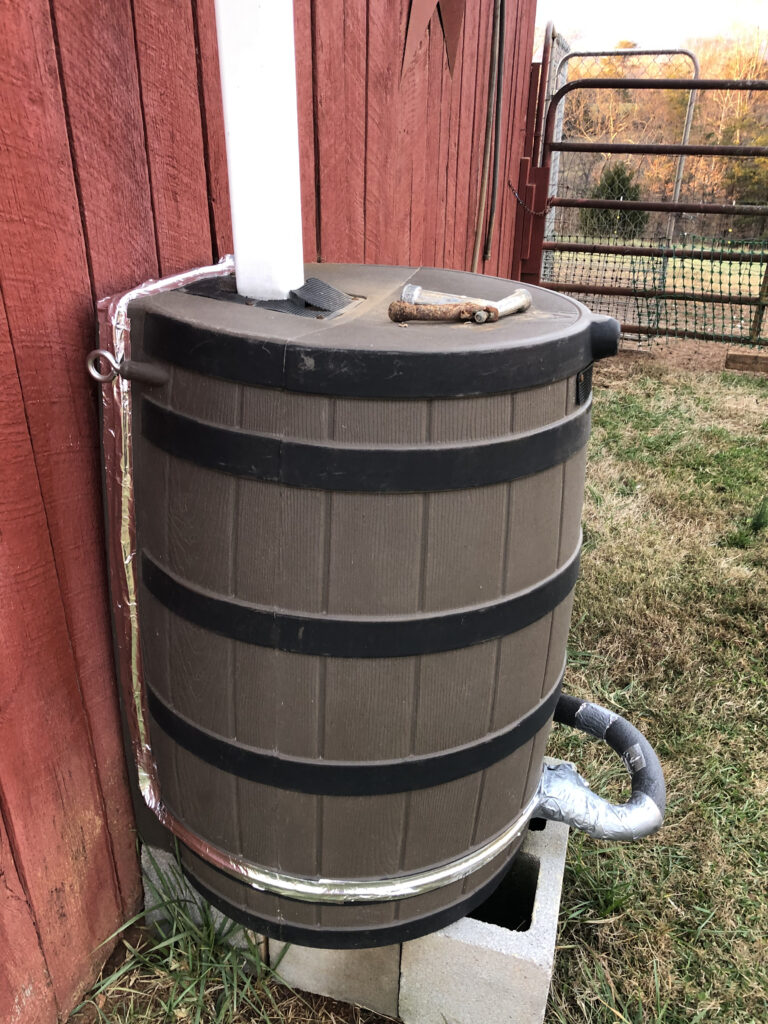
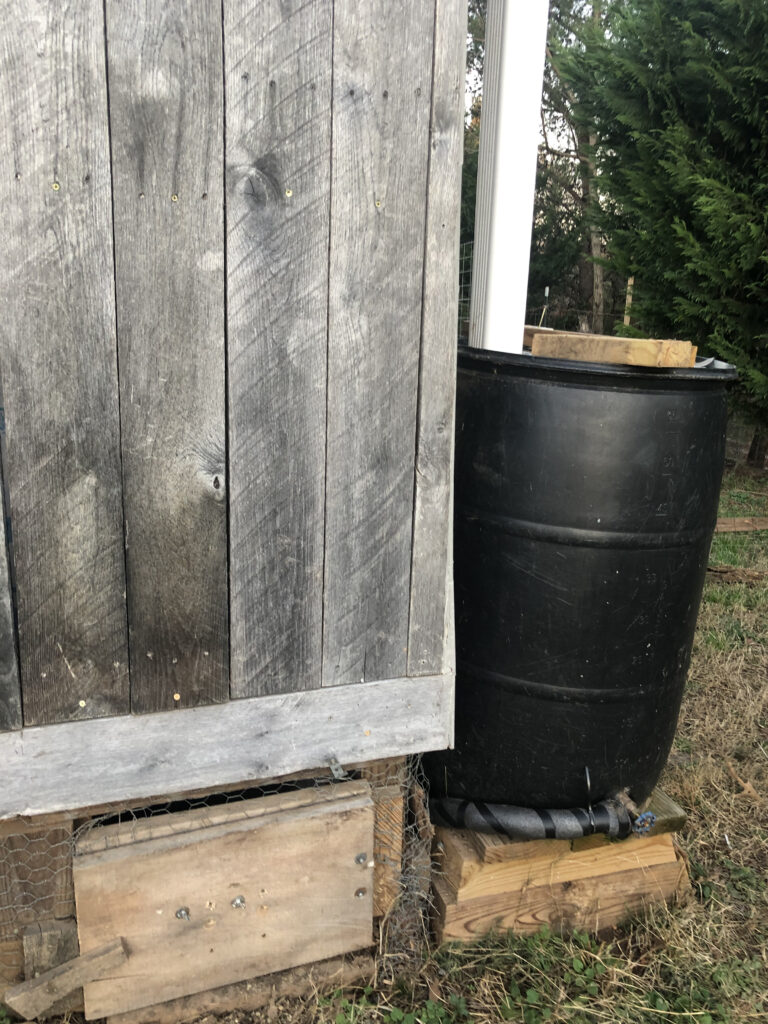
Gutters on your coop can be used to divert water to a rain barrel. No need to lug water, or drag a waterhose over to your coop. The water is there and accessible.
Automatic Waterer
Attach an automatic waterer to your rain barrel, and you’ll have an endless supply of water available for your chickens, as long as your barrel is filled with water. We used this automatic waterer in our chicken coop, and it has eliminated the hassel of filling our chickens’ water every couple of days. When traveling away from home, it has also given us peace of mind that chickens have ample water in case our housesitter forgets to check.
Winter here can get pretty chilly. When the temps drop to freezing, we keep our water from freezing with heat cable. It is wrapped around the base of our barrel, along the water line, and around the base of our automatic waterer.
Ventilation
Hot summer days often mean stagnant summer air sits in the coop. It’s not uncommon to see hens roosting and panting, even with coop windows open. I installed a solar fan in the window and it works great to circulate air. Installing it facing out, so it draws warm air from inside to outside, makes a big difference. Two adjacent windows in the coop open and allow for a nice cross breeze.
DIY Feeding
There are all kinds of ideas out there for feeding chickens. Some prefer a traditonal chicken feeder. Those are economical and easy to maintain and fill, but may allow for more waste. However, chicken feeders have improved considerably and prevent excess waste. A Rent a Coop Chicken Feeder gets great reviews, is weatherproof, and feeds up to 20 chickens or 10 adult hens.
If a gutter and rain barrel system is too elaborate, consider chicken cup waterers. They are very popular even among DIYers making their own PVC waterers with chicken cups. Looking for a combo waterer and feeder, chicken cup waterers and port feeder combos are growing in popularity. The reviews speak for themselves.
DIY PVC Feeder
We made our feeder out of PVC. We like that it can hold so much feed at once, and gravity pulls it in place. Our hens love it and we only have to fill it once or twice a week.
Chicken Coop Chunnel
An enclosed tunnel, made with a cattle panel bent into the shape of a tunnel, and then covered with chicken wire allows chickens to roam contained, and safely away from predators. Our chicken chunnel starts at the coop, and runs around my container garden, traveling along the back perimeter. This has drastically reduced bugs and slugs that travel across the ground over to my garden. Chicken patrol! It’s also handy to weed the garden and open a little hatch to the chunnel and feed chickens weeds and excess garden produce.
Electric Poultry Netting
Electric poultry netting is extremely convenient, because it allows chickens to free range safely away from their coop. It can be easily moved around, and hooked up to a solar charger.
Premier 1 is a well known company, who offers excellent customer service when you need it: Check out their electric poultry netting options. https://www.premier1supplies.com/c/fencing/electric-netting
Automatic Door Opener
An automatic door opener can be programmed to open and close each day. This ensures chickens’ security. I bought this JVR Chicken Coop Door Opener for my parents’ chickens and they love it.
No more early morning or late evening treks to open or close up the hen house!
Security Monitoring
If you want to be able to monitor your chickens remotely, a wireless solar powered security camera is a great idea. I use one to monitor our chickens and it works extremely well. If you’d like to read more about these cameras, check out my post Home Security Camera for Farms.
To Elevate or Not
In the past, we’ve always built our chicken coops on the ground. My parents’ coop is a section of their barn. It has a dirt floor. When cleaning, we rake and apply fresh pine shavings. However, when we built our most recent coop, we used repurposed barnwood and decided to elevate it about 24 inches off of the ground. It has a wood floor, which has required more attention.
However, the coop below is one that we saw at a bed and breakfast in Virginia. It was so well built, and charming, that we had to photograph it.
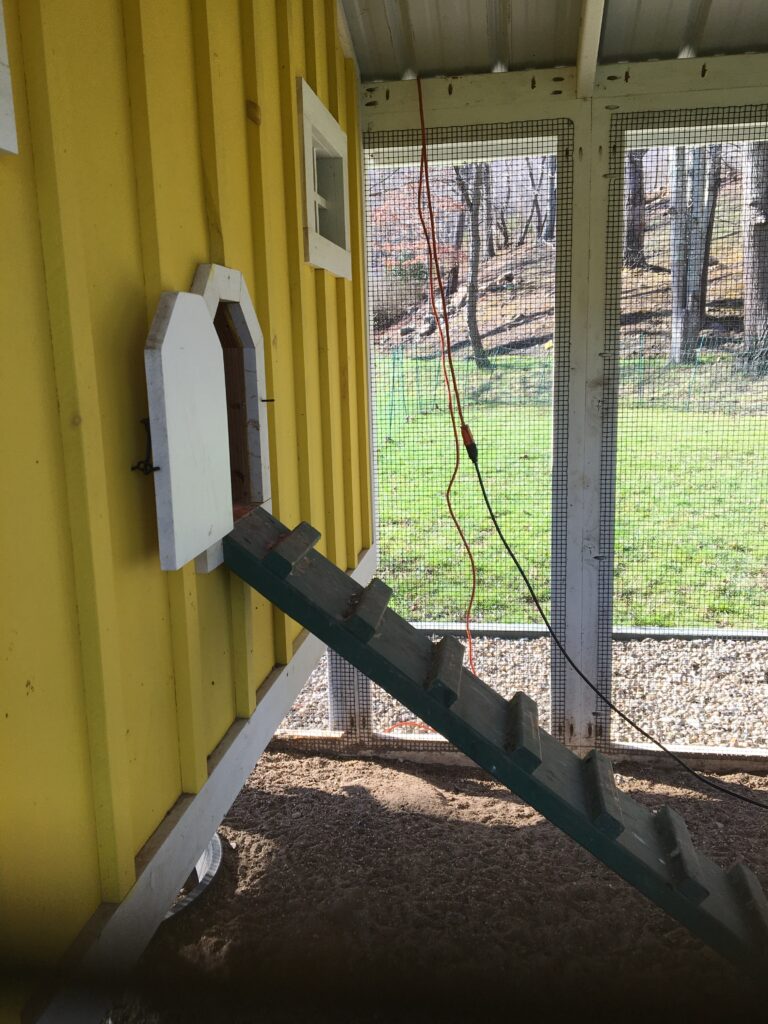
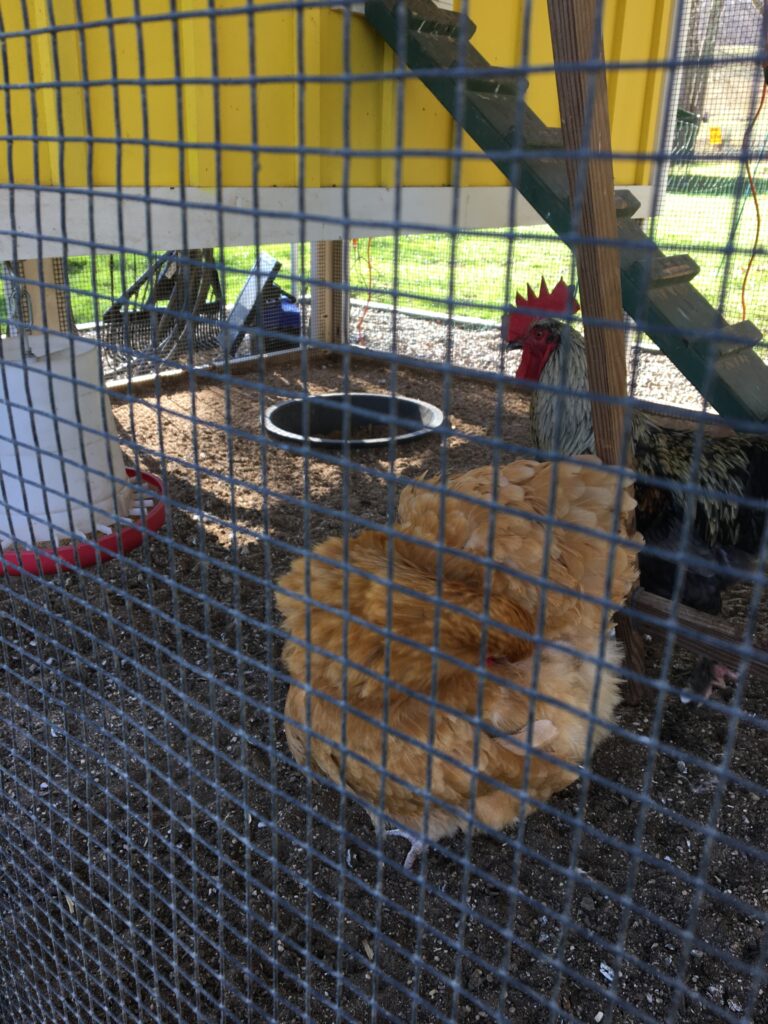
This coop offers protection from the elements. However, the floor of the above coop’s interior has to be cleaned more frequently.
Pros and Cons
Chicken Coop Ground Floor Pros
Ground floors don’t have to be raked and shoveled as frequently.
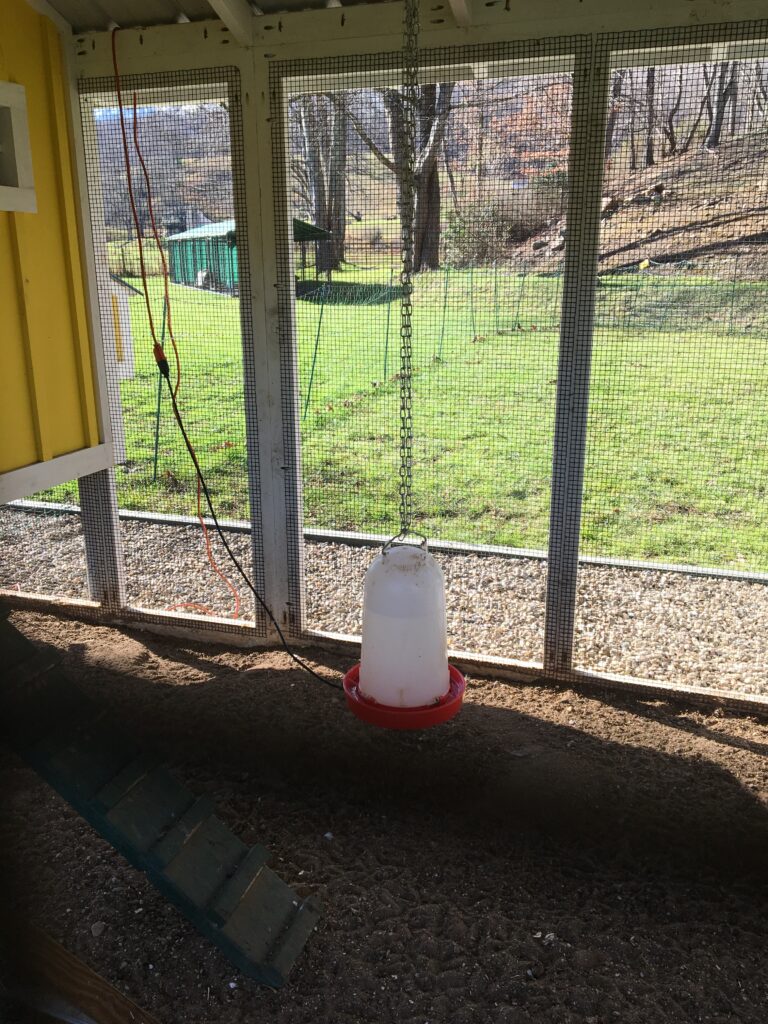
The ground absorbs odors and is more forgiving during hot and humid temperatures. However, there are products to help improve odor such as Sweet PDZ Coop Refresher or Natural Backyard Chicken Coop.
Chicken Coop Ground Floor Cons
Over time a grassy ground floor becomes dirt. Pea gravel works well at slowing erosion and keeping the ground dry. It also absorbs odors better than a wood floor.
Elevated Chicken Coop Floor Pros
An elevated coop can be contained and secured from predators. Chickens have a shelter underneath that allows for protection from heat and weather. The coop will be less dusty and offer better climate control. A hatch can be installed for ease of cleaning, where waste and shavings can be shoveled and raked into a trash can and used for compost.
Elevated Chicken Coop Floor Cons
Odors are definitely more pronounced during hot and humid temperatures. Therefore, the coop floor will have to be cleaned frequently with shavings applied.
Floor Covering
For ease of cleaning an elevated coop, a piece of repurposed vinyl flooring works well to cover the floor. It can be removed with ease when cleaning the coop.
My Chicken Coop Setup
After having had an A-framed coop, my husband and I decided we’d try something new. We built an elevated coop. We’ve tried both stationary and mobile coops in the past, but not an elevated, permanent coop. It has worked well for us.
Free Ranging
I like having the option to free range my chickens. Chickens are omnivores, so free ranging benefits them and the land. While it is a bit of an inconvenience to free range in specific areas around the farm, there are definite benefits to the effort.
Clean Up on Aisle 3! Except, it’s a goat pasture!
We have goats, and chickens are amazing at cleaning up pastures. It’s worth it to me to move them around to various areas of the farm, so they can scavange and work the land as the clean-up crew. Moving them to clean up specific areas, and bringing them back to their coop at the end of the day is worth it. They are working hard to eliminate parasites and insects in our cow pasture and goats’ pen. Think about it, I’m already committed to my chickens, so a certain amount of effort is required to experience the max benefit that they can offer. It’s just part of our lifestyle.
Mobile Coop and Poultry Netting
For now, a permanent homebase coop works great for our chickens. Likewise, being able to put 5 birds in a crate, and pulling it over to an area on our property to work and scavenge the land only adds to the health of the land. Additonally, I can use electric poultry netting in our pasture for our chickens to work the land without having too much space to roam where they may be susceptible to predators.
Coop Materials
How did I determine what coop to build? Well, we are HUGE repurposers. I love antique shops for this reason! Putting old, used, and unique things to use is part of the fun for us. For our current coop, we used old barn wood left over from a project. We used that on the side, and hardiplank boards on the front to match our greenhouse/potting shed.
Rain Barrel
Adding gutters and a rain barrel allows for more self-sufficiency with our coop. I love when a good heavy rain comes and fills up our rain barrel. We connected it to an automatic waterer and it continuously supplies fresh water for our chickens. Showers keep it topped off, and it has not failed us yet.
Egg Collecting
Egg collecting is a necessary part of each day! We repurposed several plastic crates, mounted sideways, to use as laying boxes. I’ve seen many people build their coops with an exterior small door and hatch. The allows for easy egg collecting each day, without having to enter the coop.
Roosting Poles
Sturdy branches, stripped of their leaves, make great natural looking roosting poles. It’s always amusing to me how the hens all get settled in together, lined up along the poles. I have poles placed at different heights for variety.
Windows
Not only do we like to repurpose, we like deals. Repurposed Habitat Restore windows were a deal that we couldn’t pass up. At $5 each, they fit the budget. We mounted them to be opened out, and haven’t had any issues with rainwater.
Predator Proofing
Raccoons, possoms, and foxes especially are no friends to chickens. Therefore, predator proofing is something we make our priority and focus with each coop. We didn’t want to raise our hens only to have a predator finish them off all at once! We have a hinged hatch on the floor of the coop that allows it to be closed and protected from predators at night. I find it helpful on cold nights to close the hatch door, preventing cold drafts while they are sleeping. However, if I didn’t close the hatch, the birds are protected, since their enclosed run is connected to their coop.
Wait, there’s more!
Share your coop questions, ideas, and experiences below!
It’s my sincere desire to help you along your journey of becoming more independant and self-sufficient. Way to go for making it thus far. It’s my heart to leave a legacy of helping others. If you have tips to share, I want to read them!
For more DIYs, visit Life in the Country USA regularly! If you’re building a homestead, or just getting started with gardening, check us out!
One Reply to “Chicken Coop Design Time”
Comments are closed.